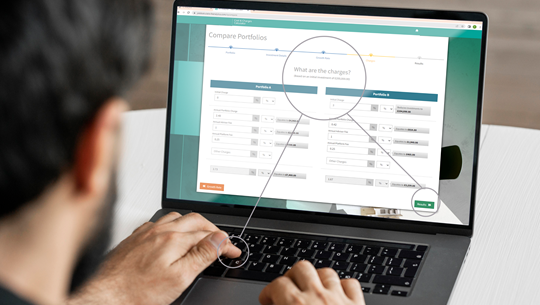Risk has never been a bigger issue for financial advisers. Not only do today’s financial advisers need to correctly assess clients’ attitude to risk and map it across to suitable portfolios – they also need to become risk management experts and ensure regulatory compliance. This blog will look at the issues raised in FE’s latest annual adviser survey, ‘Adviser business models - What lies beneath?’ and how and why asset managers should take note of the situation advisers find themselves in and help advisers better understand the risks associated with their funds.
The key issues raised
The report highlights the lack of understanding by advisers of the way the client risk profiling assessment interacts with the risk profile of the investment portfolio. Many advisers are assuming both the risk profile outputs of ATRQs and of portfolios speak the same language, and that all they need to do is simply connect the two together. An investment portfolio described as ‘medium risk’ will not necessarily be suitable for a client assessed as ‘medium risk’, yet many advisers appear to be taking this to be the case, potentially causing clients to be shoehorned into unsuitable investments. Asset managers can help by providing guidance on the underlying risks within their funds which are not always obvious, and how these may impact an overall portfolio.
For advisers that rely on third party risk mapping tools, a majority (52%) have not reviewed the underlying mapping methodology used by the tool, despite suggestions from regulatory experts that this is best practice. Half of advisers (50%) think third party risk mapping tools have limitations, with advisers describing current tools as simplistic and too generic. Qualitative research carried out as part of this study found a proportion of advisers who complain that some risk mapping tools are too generic and steer the user towards specific provider products. Advisers choosing not to use third-party risk profiling tools need to make sure they have the competence to lift the bonnet on their own investment risk processes but would also probably benefit from additional information from asset managers themselves on their products so that they are equipped to carry out detailed risk assessment.
An obligation to help
There is now a regulatory requirement under MiFID II for asset managers to ensure the target market of a fund is clearly stated and defined. The introduction of this type of regulation should in theory go some way to addressing the problems advisers are facing in that greater knowledge of the investor types specific funds are aimed at will aid understanding regarding overall suitability.
European Securities and Markets Authority (ESMA) regulation states clearly in its product guidance that asset managers must act in the clients’ best interests during all the stages of the life-cycle of products or services and[1] consider:
- The type of clients to whom the product is targeted.
- Knowledge and experience – the firm should specify which knowledge the target clients should have about elements such as the product type and product features.
- Financial situation with a focus on their ability to bear losses – the firm should specify the amount of losses a client is willing and able to afford
- Risk tolerance and compatibility of the risk/reward profile of the product with the target market – ESMA suggests that basic risk attitudes should be categorised (and give the examples of 'risk orientated', 'balanced' or 'conservative').
- Clients' objectives – the firm should specify the investment objectives of target clients and ESMA gives the examples of references to liquidity supply, retirement provision or the number of years the investment is to be held.
- Clients' needs – MiFID II introduced the concept of 'needs of an identified target market of end clients' and so the firm should specify aspects of the investment and expectations of targeted clients.[2]
A golden opportunity to stand out
Apart from a legal obligation, asset managers should be looking at the issues outlined in the research report as a golden opportunity to differentiate themselves from competitors. A point of differentiation could be the extent to which asset managers work with advisers, their primary distribution channel, to educate them on the topic of risk, which is complex and multi-dimensional.
For asset managers, educating advisers with quality research and information that can assist them with their due diligence and investment process is mutually beneficial as an opportunity to promote their funds and is an ‘added value’ service to advisers.
How can asset managers connect with advisers?
That said, Advisers are often bombarded with information from asset managers and it can be hard to make sure yours gets read. An asset manager’s website may not necessarily be the first point of call for an adviser. If an adviser is looking for more information about funds, particularly risk information, they may look for informative content that is presented in a reader-friendly way and is distributed through the channels that an adviser would more naturally turn to. This doesn’t mean that an asset manager should not produce content on their own website, but a multi-pronged plan of action can lead to better exposure.
Third-party solutions such as FE Connect enable asset managers to distribute their research and engage with over a third of advisers directly through FE Analytics and FE Trustnet. FE Connect helps you strategically position all your research and insights, at the point the adviser is undertaking research on your fund. Using FE Connect will enable you to publish all your fund and market research simultaneously on to FE Analytics and FE Trustnet, thereby making it accessible to more than 84% of the top IFA firms in the UK and about 300,000 Trustnet users. The real benefit being that asset managers get the opportunity to differentiate beyond the hard data.
Asset managers must remember that helping advisers should be looked at as a mutually beneficial process. With your help, advisers can make better investment decisions for their clients, while advisers will continue to work with asset managers if they see that the guidance they are receiving is producing the right results for the end investors. The manpower that an asset management firm possesses when it comes to detailed risk assessment and management dwarfs that of an adviser, so they should be looking to use this to their advantage.
Now with the regulatory obligation to ensure that there is a much greater clarity and understanding of risk in the industry, both by advisers and the end investors, in the form of the target market requirements, it’s a great time for asset managers to act on the findings of our research report to improve understanding throughout the industry.
[1] https://www.esma.europa.eu/sites/default/files/library/esma35-43-620_report_on_guidelines_on_product_governance.pdf
[2] https://www.ashurst.com/en/news-and-insights/legal-updates/mifid-12-mifid-ii-product-governance-how-to-assess-target-market/
Click here to download the full research report: ‘Adviser Business Models – what lies beneath’, or here to find out more about how we can help.


